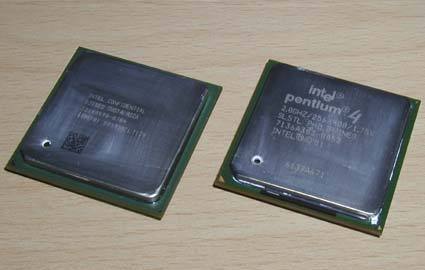Good Old Newbie: Intel's Celeron 1.7 GHz for Socket 478
The Core: P4 Willamette
This image shows both the new Celeron 1.7 (left) and the Pentium 4 Willamette (2 GHz). Both outside and inside, there is no real difference between these two processors. The new Celeron is nothing more than a Pentium 4 Willamette that has had half of its L2 cache removed. Everything else is pretty much the same:
- 100 MHz quad-pumped Front Side Bus (= 400 MHz), providing 3.2 GB/s
- High clock speeds (1.7 GHz, faster versions to follow)
- 1.75 V core voltage
- Socket mPGA478
- 128 kB full speed L2 cache
- Instruction Trace Cache
- Rapid Execution Engine
- SSE2-Instruction Engine
Are you disappointed because Intel didn't decide to use the Northwood core? Well, you really shouldn't be! First of all, Intel still has large production capacities for 0.18 µm that should not lie idle. The "old" Celeron architecture, based on the Tualatin core, suffers considerably from the limited bandwidth of conventional SDRAM, so it was time for an appropriate replacement.
It was important for Intel to switch to Socket 478, because it enables much faster clock speeds, even for low-end processors. Also, system integrators and OEMs will be able to buy higher quantities of motherboards and memory, since they now have the option to choose freely from various components, including chipsets. And it helps to shut out competition from VIA and their C3 processor, which have certainly spoiled Celeron sales a bit.
Finally, don't forget that there's another CPU core waiting in the wings - yes indeed, get ready to see Celerons based on the Northwood core, as soon as clock speeds exceed 2 GHz.
Get Tom's Hardware's best news and in-depth reviews, straight to your inbox.
Current page: The Core: P4 Willamette
Prev Page Intel Celeron Willamette: Hunting Down AMD's Duron? Next Page Architecture Diagram Of The Celeron Willamette
Patrick Schmid was the editor-in-chief for Tom's Hardware from 2005 to 2006. He wrote numerous articles on a wide range of hardware topics, including storage, CPUs, and system builds.
